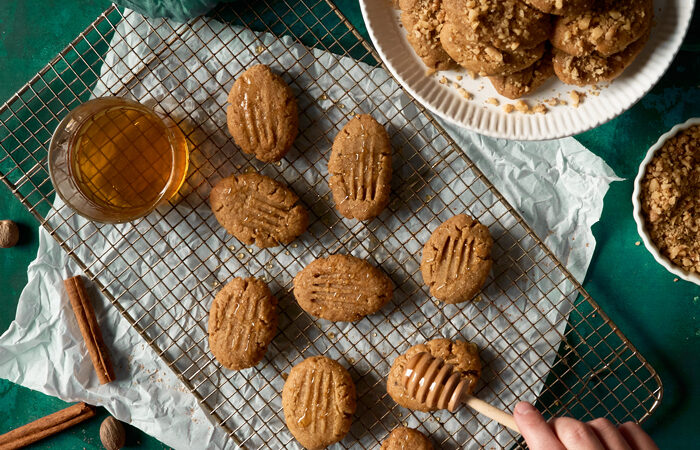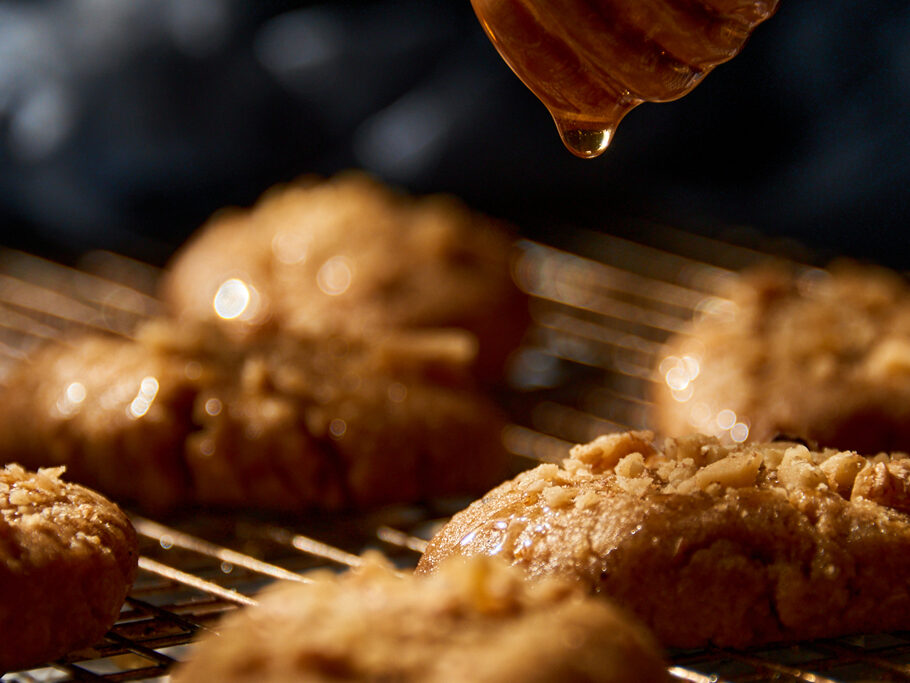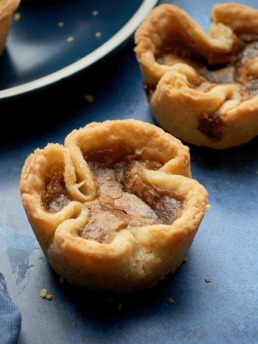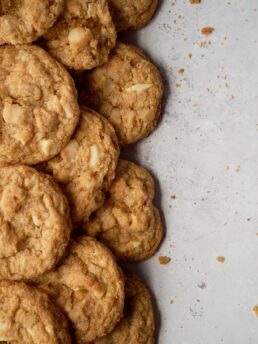Melomakarona: Greek Honey Cookies

These Melomakarona (Greek honey cookies) are my modern take on a traditional cookie. Typically Melomakarona only use oil for fat. They also use either a mix of semolina and all purpose flour or just all purpose flour. My recipe uses both some brown butter and cake flour in the dough. These changes give the Melomakarona a loose crumb and soft texture that really absorb the honey syrup they are soaked in.
I have to say, there is something incredibly satisfying about biting into what feels like a solid cookie in your hand and having it just melt away in your mouth.

Get the Recipe: Melomakarona
Ingredients
Cookie Ingredients
- 6 tablespoons unsalted butter, browned
- 1 cup cake flour
- 1¼ cups all purpose flour
- ¾ cup semolina flour
- ½ teaspoon baking soda
- 1 teaspoon baking powder
- ½ teaspoon kosher salt
- 1¼ teaspoons whole cinnamon, freshly ground
- ½ teaspoon whole cloves, freshly ground
- ½ teaspoon whole nutmeg, freshly grated
- zest of 2 oranges
- ¼ cup honey
- 4 tablespoons extra virgin olive oil
- 3 tablespoons canola oil, or other neutral oil
- 1 tablespoon cognac, brandy
- 6 tablespoons orange juice, fresh squeezed
- honey and chopped walnuts, for topping
Syrup Ingredients
- 1 cup water
- 2 cups granulated sugar
- ¾ cup honey
- 2 cinnamon sticks
- 3 whole cloves
- ½ an orange
Equipment
- 1 sauce pot
- 1 sauce pan
- 1 medium bowl
- 2 whisks (wet & dry)
- 4 small bowls
- 1 microplane or fine grater
- 1 spice grinder (optional)
- 1 stand mixer with beater and bowl or hand mixer
- 1 spatula
- 2 baking trays
- 1 #50 cookie scoop (optional)
- 1 fork
- 1 cooling rack
Instructions
- First, make the syrup. Add all the ingredients for the syrup, except the honey, to a small sauce pot. Bring everything to a boil for 3-4 minutes. Once all of the sugar has dissolved, remove the pot from the stove and set aside to cool either on the counter or in the refrigerator.
- Next, add the butter to a small saucepan on medium heat. Make sure to continuously stir or swirl the pan as the butter melts and then froths. When you see the milk solids turn a light brown color, turn off the stove and move the pan from the heat. The butter will continue to cook and should end up a nice warm brown. Let it cool just enough to pour into a small bowl or container and place the browned butter in the refrigerator to re-harden for about 30-45 minutes.
- Now you can prepare the rest of the ingredients for the dough. In a medium bowl mix the semolina flour, cake flour, AP flour, baking soda, baking powder, salt, and spices with a whisk and set aside. Next, add the rest of the ingredients into 4 small bowls: one with the honey; one with the orange zest; one with the oils; and one with the orange juice and the cognac. Set those aside too.
- Preheat your oven to 350°F (177°C). By now the brown butter should be chilled and hardened. Scrape it out of the bowl and into the bowl of a stand mixer with beater attachment. Turn the mixer to medium speed and let it whip for 2-3 minutes. The butter will lighten and increase in volume. About 30 seconds into whipping add in the orange zest. Once whipped, drizzle in the honey until incorporated and then add in the oils. The mixture will be very liquid.
- At this point, you can begin adding in the flour and orange juice mixtures in tandem. Add ¼ of the flour, ⅓ of the liquid, ¼ flour, etc until both are gone. As soon as the flour mixes in, stop the machine. Do NOT overmix. The dough should be very soft and slightly sticky. If you overmix the dough it will toughen and the syrup won't soak through the cookie.
- Now, it's time to shape the first batch of cookies. Because the cookies need to be HOT when they are soaked into the syrup (for better absorption), I suggest making between 8-12 cookies in each batch for 2 rounds of dipping per batch. The syrup recipe makes enough for dunking between 3-4 cookies at a time, so you need to work quickly even with smaller batches.
- First, line two baking trays with silicone mats or parchment paper. Use a #50, 1.6in (4cm) cookie scoop to portion out a cookie. Each one should be roughly 1.3tbsp or 20-25g of dough. Roll the scooped dough into a log and gently press it between your palms to make an egg shape cookie. It will be roughly 1/3in (.75cm) thick. Lay the cookie down and use the back of a fork to press tang marks into the dough in a rolling motion from base to prongs. You can also simply prick the fork prongs into the cookie a few times. The cookies won't spread so they can be relatively close to each other if needed. Bake the cookies for 20 minutes.
- While they are baking, setup your dipping station. Place a cooling rack on top of parchment paper or aluminum foil. Bring over your now-cooled syrup and remove the orange, cinnamon, and cloves. Mix in the honey and set aside for dipping. You may also want to use either an offset spatula or fork to lift and drop the cookies into the syrup. I use my fingers, but they are pretty heatproof at this point. Finally, make sure the leave space for the hot pan to go so everything is within reach.
- When done, the cookies will be just crisp on the outside and still soft and spongy in the middle. Quickly move 3-4 cookies at a time to the syrup and push them gently under for 5-7 seconds. Flip each cookie over and submerge again for another 5-10 seconds. The cookies will darken in color and soften as they absorb the honey. Gently remove them and move them to the cooling rack.
- Repeat the process until all of the hot cookies have been soaked. Then form another batch of cookies, bake, and dip them in syrup. The recipe should make between 30-34 cookies.
- After the honey has fully absorbed into the cookies and they have cooled, drizzle fresh honey over them and top with chopped walnuts.
Notes
- Melomakarona get better with time. Peak eating is between 2-5 days after making them.
- Store the melomakarona at room temperature (only), in an airtight container, for up to 2 weeks.
- If you don’t mind have a ton of extra syrup, double or triple that portion of the recipe so you can dip more cookies at a time. The trick is to have a maximum of 3 dipping rounds per batch of cookies, otherwise they become too cool to absorb enough syrup. The less rounds, the better.
- If you really want to, you can dip the cookies longer than instructed, but I wouldn’t recommend much more time. If the cookies start to fall apart, they’ve soaked for too long. (I know it’s obvious, but here we are.)
Nutrition

Frequently Asked Questions
Some recipes call for cooled cookies and hot syrup and others (like mine) say hot cookies and cooled syrup. I’ve found that cookies right out of the oven are still puffy from the baking soda and baking powder. This textural difference allows them to really soak in the honey better than if they are previously cooled.
If you don’t have access or the ability to grate or grind whole spices, you can absolutely use pre-ground spices. The flavors won’t be quite as strong, but you can always add more to your tastes. Just make sure to keep the ratios the same.
Please note: Traditionally, the spices are supposed to be subtle, but I want you to eat the cookie you want to eat. Be as bold as you like.
Okay, okay, I know it’s a lot to ask, but I promise each has a purpose.
The semolina flour has a higher amount of protein (avg. 13%) than AP flour (avg. 10%) and cake flour (avg. 8%). This makes it a honey-absorbing powerhouse. It also still manages to keep its texture because it isn’t so finely milled as AP flour and cake flour. This is a huge part of the final texture of the cookie.
The mix of all purpose flour and cake flour are important for the final texture as well. I wanted my version of these cookies to be very soft, so they would both soak up more honey and melt away in a few chews. The addition of cake flour just softens the cookies’ texture enough to make that a reality.
Also, AP flour’s higher protein and, thus, gluten content makes it really easy to quickly overmix and tighten up the dough. The use of cake flour allows a little more wiggle room before the dough becomes overmixed and tough.
This answer is actually a simple one. Ready? Olive oil has too strong a flavor to be the only oil used in the dough. Seems obvious now that I said it, right?! If you use one part olive oil and one part neutrally flavored oil the dough takes on a subtle olive oil flavor that won’t overwhelm the spices and honey.
Traditionally these are treats eaten during the Christmas or Lenten season, when Orthodox Christians abstain from eating meat and their by-products (eggs/dairy).
If you are looking for a more traditional version, follow the recipe instructions but change the ingredients in the dough as described below. In fact, if you are up for it, make both versions and let me know which you prefer!
1. Substitute the butter with half olive oil and half neutral oil.
2. Use 6 tablespoons (90g) of granulated sugar instead of honey.
3. Instead of cake flour use an extra 3/4c (90g) of all purpose flour and 1/4c (45g) of semolina flour.
Of note: The Orthodox Christian definition of meat is anything with a backbone. As bee’s do not fall into this category, honey is fine to use. If you are vegan and abstain from all animal by-products, please don’t listen to anyone who says these are vegan.



